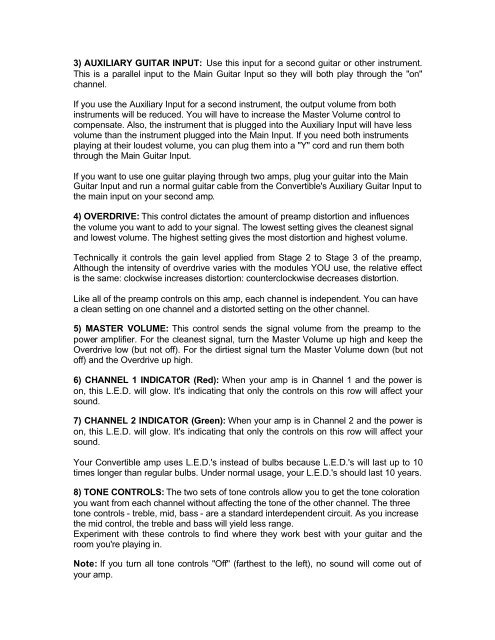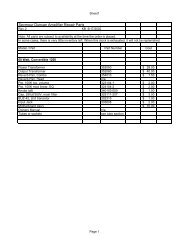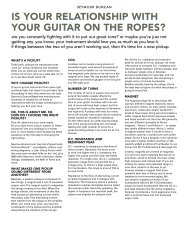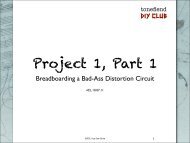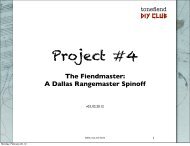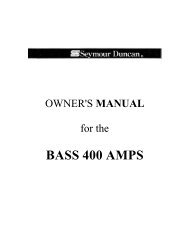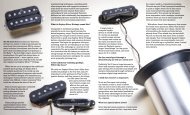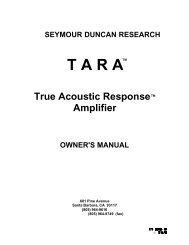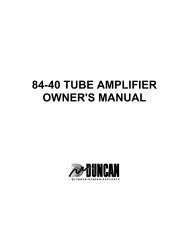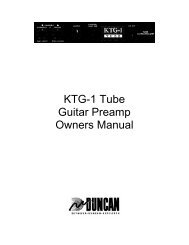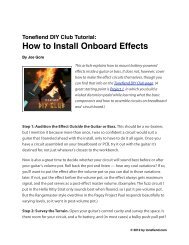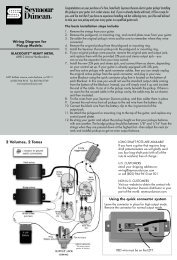100 Watt Convertible™ Amp - Seymour Duncan
100 Watt Convertible™ Amp - Seymour Duncan
100 Watt Convertible™ Amp - Seymour Duncan
You also want an ePaper? Increase the reach of your titles
YUMPU automatically turns print PDFs into web optimized ePapers that Google loves.
3) AUXILIARY GUITAR INPUT: Use this input for a second guitar or other instrument.<br />
This is a parallel input to the Main Guitar Input so they will both play through the "on"<br />
channel.<br />
If you use the Auxiliary Input for a second instrument, the output volume from both<br />
instruments will be reduced. You will have to increase the Master Volume control to<br />
compensate. Also, the instrument that is plugged into the Auxiliary Input will have less<br />
volume than the instrument plugged into the Main Input. If you need both instruments<br />
playing at their loudest volume, you can plug them into a "Y" cord and run them both<br />
through the Main Guitar Input.<br />
If you want to use one guitar playing through two amps, plug your guitar into the Main<br />
Guitar Input and run a normal guitar cable from the Convertible's Auxiliary Guitar Input to<br />
the main input on your second amp.<br />
4) OVERDRIVE: This control dictates the amount of preamp distortion and influences<br />
the volume you want to add to your signal. The lowest setting gives the cleanest signal<br />
and lowest volume. The highest setting gives the most distortion and highest volume.<br />
Technically it controls the gain level applied from Stage 2 to Stage 3 of the preamp,<br />
Although the intensity of overdrive varies with the modules YOU use, the relative effect<br />
is the same: clockwise increases distortion: counterclockwise decreases distortion.<br />
Like all of the preamp controls on this amp, each channel is independent. You can have<br />
a clean setting on one channel and a distorted setting on the other channel.<br />
5) MASTER VOLUME: This control sends the signal volume from the preamp to the<br />
power amplifier. For the cleanest signal, turn the Master Volume up high and keep the<br />
Overdrive low (but not off). For the dirtiest signal turn the Master Volume down (but not<br />
off) and the Overdrive up high.<br />
6) CHANNEL 1 INDICATOR (Red): When your amp is in Channel 1 and the power is<br />
on, this L.E.D. will glow. It's indicating that only the controls on this row will affect your<br />
sound.<br />
7) CHANNEL 2 INDICATOR (Green): When your amp is in Channel 2 and the power is<br />
on, this L.E.D. will glow. It's indicating that only the controls on this row will affect your<br />
sound.<br />
Your Convertible amp uses L.E.D.'s instead of bulbs because L.E.D.'s will last up to 10<br />
times longer than regular bulbs. Under normal usage, your L.E.D.'s should last 10 years.<br />
8) TONE CONTROLS: The two sets of tone controls allow you to get the tone coloration<br />
you want from each channel without affecting the tone of the other channel. The three<br />
tone controls - treble, mid, bass - are a standard interdependent circuit. As you increase<br />
the mid control, the treble and bass will yield less range.<br />
Experiment with these controls to find where they work best with your guitar and the<br />
room you're playing in.<br />
Note: If you turn all tone controls "Off" (farthest to the left), no sound will come out of<br />
your amp.


